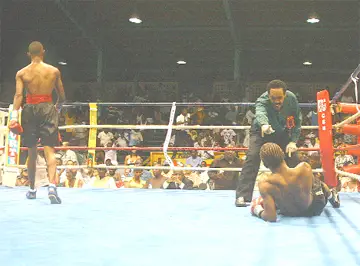Finisher

What is a finisher?
A finisher is simply (how ironic) a drill, an exercise or a collection of exercises performed at the end of a workout designed to challenge a person’s mental toughness and push an individual’s cardiovascular system (stamina), nervous system (reaction & explosiveness) and/or the musculo-skeletal system (muscle strength & endurance) to the ultimate maximum to yield cosmetic changes or promote performance enhancements.
Pull up & broad jump finisher: 3 pull ups: 1 broad jumps, 6:2, 9:3, 12:4, 15:5, 12:4, 9:3 6:2, 3:1
OR
Tabata (20sec work : 10sec rest) Finisher: 5 Yd Shuffle, Turn & Run, Fwd / Bwd Run & Burpees
OR
5min Ab Finisher: Seated Trunk Rotation, Push Up T, Spider March, Shoulder Double Taps & Star Plank
Who uses finishers / who are they for?
Finishers are common with athletes from youth levels to elite and with fitness or physique oriented individuals. Most anyone from elementary aged kids  to seniors and out of shape to the superfit
to seniors and out of shape to the superfit  can use a finisher, so long as considerate program design is used. Considerate program design means, not being an idiot and giving an NFL linebacker’s finisher program to a 50 year old sedentary individual or vice versa, as well as taking into account the individual or groups training age (experience), health history, current level of fitness, goals, height, weight, relative strength to body weight, mobility, training frequency, workout duration, exercise selection, load, time length of finisher and more.
can use a finisher, so long as considerate program design is used. Considerate program design means, not being an idiot and giving an NFL linebacker’s finisher program to a 50 year old sedentary individual or vice versa, as well as taking into account the individual or groups training age (experience), health history, current level of fitness, goals, height, weight, relative strength to body weight, mobility, training frequency, workout duration, exercise selection, load, time length of finisher and more.
Rationale behind doing them
The reason I added the finisher to your workouts is 3 fold. (1), I want you to be the tough & in the best shape of your lives. (2) You’re teammates are sadistic and requested them and (3) you’re program is designed to get you to move better, feel better and lose weight/fat, but a finisher represents the final details: the accessories to a good outfit, the crown molding or fixtures in a renovated house or the candles & music to accompany a fine meal and finer guests.
The reasons we might do an ab finisher, upper body finisher, lower body finisher or total body finisher are to increase muscle definition for the abs, upper body or lower body or to increase fat loss/weight loss if using a total body finisher.
Where I got the idea from?
I first got the idea while playing sports growing up. Almost every coach used a finisher to improve our performance on a particular skill or to increase our conditioning levels. At baseball practice our coaches would hit us continuous fly balls (I was a darn good centerfielder), in all directions until we couldn’t run anymore or make the plays. He’d even cheat by hitting another ball before we caught the first ball. By the end of the year, I owned that drill. He’d get tired before me. J
In basketball, our coaches would finish practice by having us do suicide runs or ladder drills for conditioning. He’d then conveniently, when we were keeled over with hands on knees, sucking wind, ask one of us to win the game / finish practice by making a free throw. Sometimes we’d hit it and sometimes we wouldn’t.
I never used finishers like you’ve experienced, with my personal training clients until 3 years ago. I didn’t know how to use such a tough drill for non-competitive athletes (my training background started in professional baseball, soccer and collegiate sports). Then I read Alwyn Cosgrove’s Afterburn Fat Loss Manual
and he showed me how to use finishers with personal training client by selecting specific exercises in place of drills. Then another colleague, BJ Gaddour, the co-creator of Workout Muse, showed me how, in his Rapid Fat Loss Boot Camp System, to use finishers in a boot camp setting by using timed sets instead of rep based sets.
Thank those guys or not. J
When do you use Finishers?
You can use finishers most anytime, but not all of the time. In a boot camp system like ours where you train 4 weeks and get 1 week off for recovery, it is safe. Your body & mind both get recovery from the high intensity demands of the program.
In a traditional strength & conditioning program lasting longer than 4 weeks and more like 8-12 weeks in length, I think it would not be the best idea to have a finisher every day of every workout for the entire length of the program without a day off. It would be tough on your body and your mind and possibly lead to overtraining if not well managed.
The best time to use them is at the end of a workout or a section of a workout (for example either at the end of your strength circuit or at the end of your entire workout).
What’s the physiological benefit?
The physiological benefit is it shapes your body best. It forces you to break through barriers and by breaking through these barriers your body responds by changing. If you isolate a specific body region, as in an ab finisher, it should provide the extra toning, firming and muscle definition you desire. (I say, “should” because you still have to improve your nutrition and complete your conditioning minutes, otherwise you’ll just spin your wheels).
What’s the psychological benefit?
The psychological benefit is you’ll be mentally tougher and less intimidated by finishers. In fact, you’ll come to see finishers as challenges and welcome them because of your success rate of completing and beating them. You’ll have greater confidence in your mind and in your body’s ability to perform at a high level, while under stress, and in a fatigued state. You’ll be bad ass. And ladies. It’s not a bad thing to be bad ass. You can still be the gentler, sweeter and more understanding sex, but know that confidence in your self is really sexy.
You’ll have a love-hate relationship with them.
You hate using them, but you sure are grateful, when you’re done and the benefits you earn afterwards. Rookies don’t ever do anything that hurts. If you have reservations or concerns about doing something, don’t do it and talk to me about it first. Otherwise give it a shot. You’re here to get better and make mindshifts and this is another opportunity
How do you do a finisher safely?
That’s a good question, and an a similar question would be, how do you differentiate a finisher from just doing something really difficult at the end of a workout? Anyone can make you sweat, but it takes a competent coach to consider all possible variables related to the individual and group when designing a finisher.
Please know that’s why each exercise has 3 levels to address different conditioning levels, the finisher is set to time so you can go at your own pace and then sometimes I’ll modify the exercises to the individual if it’s necessary.
Summary
Finishers were introduced to provide the extra detail to your body changes and were requested by you and/or your peers to be included in every workout. You will develop a love-hate relationship with them: relishing the challenge before it begins, sometimes hating them in the moment, and loving the results and how you feel after the fact.
Your coach,
Mike Alves
References
Cosgrove, Alwyn. Afterburn: Extreme Fat Loss Training. California: Cosgrove Results Fitness Training, 2004. Print.
Cosgrove, Alwyn. Afterburn II: The Body Furnace Program. California: Cosgrove Results Fitness Training, 2006. Print.
Gaddour, B.J. Workout Muse: The Rapid Fat Loss Boot Camp System. Milwaukee: GGR Fitness, 2008. WorkoutMuse.com. Web. 2008.
